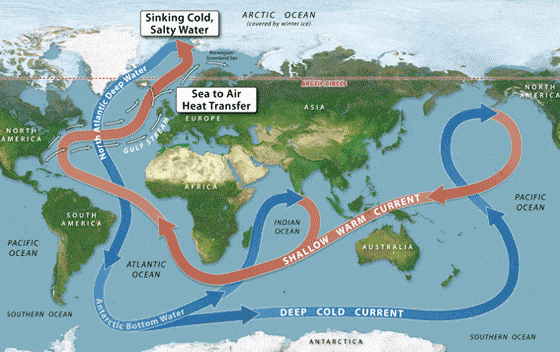What is Happening?
- The Greenland ice sheet is melting.
- The ice sheet melting will result in less saline (less dense) water entering the North Atlantic Ocean and floating on top of it instead of sinking, causing less and less deep water currents to moderate the globe’s climate, especially Northern Europe’s.
- Deep water currents are mainly formed at the Poles where the cold atmosphere cools the surface water and, in cooling, ice forms and, as ice forms, salt is rejected into the remaining water, causing it to sink and push less dense water to the surface.
How is it meant to work? What does it do?
- Deep water circulates from the North Atlantic Ocean to the Southern Atlantic Ocean and East to the Indian Ocean.
- It returns to the surface in the Indian and Pacific Oceans through the process of upwelling.
- The warm, shallow current then returns west past the Indian Ocean, around South Africa and up to the North Atlantic where the water becomes more saline and cold. It then repeats itself.
- Completing the conveyor belt takes approx. 1000 years.
- The Global Ocean Conveyor Belt moderates Earth’s temperature and precipitation.
How has Global Warming affected the Atlantic Conveyor Belt/ Global Ocean Conveyor Belt?
- The Greenland ice sheet is melting. Additionally, the melting ice releases CO2 trapped in the ice from when the ice formed thousands of years ago.
- As less dense fresh water enters the North Atlantic, it lessens the water’s salinity, thus preventing North Atlantic Deep Water, which drives the Global Conveyor Belt, from forming. The Global Conveyor Belt is dependent on thermohaline circulation.
- When less North Atlantic Deep Water forms, less CO2(g) is absorbed from the atmosphere into the ocean. As more CO2(g) is let into the atmosphere through less North Atlantic Deep Water currents forming, Earth’s global temperature increases because of the greenhouse effect.
Consequences
- Because the Conveyor Belt transports heat throughout Earth, once it collapses, Earth will face a rapid cooling period similar to the Younger Dryas period approx. 11000 years ago where large discharges of freshwater from a glacial lake in North America entered the North Atlantic Ocean, slowing thermohaline circulation. Also, the Greenland ice sheet melting would raise sea levels about 7.2 metres, flooding land enormously all over the globe.
